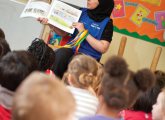Early Years Practitioner Paula Brown tells TEY about her experiences of Best Practice Network’s Play and Children’s Learning: EYFS in Practice course…
PB: I ran a children’s yoga and music and movement session for about four years, privately. I had done training for it, but I wanted to consolidate that and learn more about child development; so, I applied for the full pathway of the EYPS course. As part of that, Best Practice Network ran various courses on subjects such as communication, parents and the EYFS. Having completed my EYPS course, I’m now working in a preschool where I did my second placement, as a deputy manager.
PB: It was delivered by one of Best Practice’s teachers, a man called Richard Ford, and it was jam-packed! First, he got us talking about our earliest memories of play experiences – where they were and who was involved. We had quite a big discussion about that, trying to pull out ideas about adult involvement in play – in particular, issues of supervision, whether we had been allowed to get bored, and also the differences between the ways things were done then and how they are done now.
Next we got the Foundation Stage documents out and looked at any references to play in the practice guidance and the statutory framework, looking for specific mentions of it, as well as general ones. That was really interesting and brought out how it all revolves around play – and how you would go about recognising that. We then discussed different kinds of play: what play means and how you might support it.
We also looked at different schemas and the ways in which they can be supported; planned and spontaneous play; and then at how we could evidence for Early Years Professional Status: how you could find evidence around play and planning. Finally, there was an action plan at the end addressing our own strengths and weaknesses. There was quite a lot to get through in one day, but it was really good.
PB: I think the way Richard began with getting us to remember our own play – what it meant and how it felt – was really useful. Sometimes when you’re on a professional course you can get so carried away with reading the academic material that you can forget to take it back to tap into what children are actually doing.
The way in which schemas were covered was also interesting. Rather than being overly academic, it was, “Right, I’m sitting here with a bunch of four-year-olds, what am I actually supposed to be doing to support them? What equipment should I provide? How should I change my routine to give them time to explore this?”. All in all, it was quite a practical course.
PB: The action plan at the end was really good – it meant you could review what you needed to know more about, and what you could incorporate into your practice; I found that very helpful. And, again, going over the schemas in a discussion group, and making it really practical, was really useful too.
The course couldn’t cover everything, but it made you think about a lot of different areas, allowing you to go away and find out more.
For more information on courses available from Best Practice Network, visit bestpracticenet.co.uk

Interview: Training to Support Toddlers
Ace-Owner

Why Middle Leadership Matters in the Foundation Stage
Ace-Foundation-Stage-Leader

Early years apprenticeship programmes
Editors picks

Staff Appraisals
Ace-Owner
